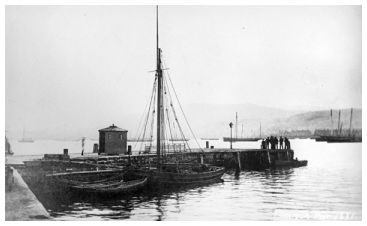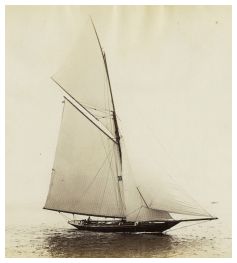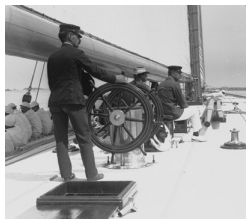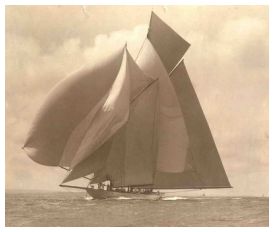Yves GARY Hits: 9208
Category: SKIPPERS & CREWS
 Who is this genius?
Who is this genius?
And what his training that so peculiarly fitted him for his high estate? A Scotchman by birth, a sailor by nature, a grocer by early training, and navigator and helmsman of imperishable fame by dint of indomitable will, unequaled skill, infallible judgment, and an irrepressible love of boats and all that pertains to them.
Of diminutive stature, but wiry, agile figure, dark-complexioned, accentuated by his bronzed, weather-beaten cast, with black close-cropped mustache and piercing black quick eye.
Capt. Barr was born in Gourock, Scotland, in July, 1864. His forbears had been sailors, but his father had abandoned the trade and was strenuously opposed to his son's following it.  Charlie was apprenticed as a grocer’s clerk to prevent him following in his brother’s footsteps, a tendency displayed in his boyhood by running off with every boat he could steal aboard whenever opportunity presented. The landsman’s life grated upon him, and finally he prevailed against the family judgment and went before the mast in a flounder trawler, where he spent two years fishing and met with some thrilling experiences which unquestionably developed his courage in danger and his judgment in emergency. Realizing the unswerving determination of the youth, Barr’s older brother, John, than whom there was not a better skipper in Gourock, took him under his wing and gave him a position as foremast on his little ten-ton cutter Ulerin. And he served his apprenticeship ungrudgingly. It was a hard life of exposure, of water and ice, of blows and calms, but it developed the sailor’s soul within him, and he loved it. In a few years he was given the tiller and became “Capt’n” Barr.
Charlie was apprenticed as a grocer’s clerk to prevent him following in his brother’s footsteps, a tendency displayed in his boyhood by running off with every boat he could steal aboard whenever opportunity presented. The landsman’s life grated upon him, and finally he prevailed against the family judgment and went before the mast in a flounder trawler, where he spent two years fishing and met with some thrilling experiences which unquestionably developed his courage in danger and his judgment in emergency. Realizing the unswerving determination of the youth, Barr’s older brother, John, than whom there was not a better skipper in Gourock, took him under his wing and gave him a position as foremast on his little ten-ton cutter Ulerin. And he served his apprenticeship ungrudgingly. It was a hard life of exposure, of water and ice, of blows and calms, but it developed the sailor’s soul within him, and he loved it. In a few years he was given the tiller and became “Capt’n” Barr.
 Then an opportunity came to him. His brother John was sent to this country in 1885, in charge of the fifty-three-foot racing cutter Clara designed by William Fife, of Fairlie. Charlie shipped as foremast hand. His skill was soon manifest.. The trip occupied forty days’ time, and many of them trying days in treacherous weather. In their first year Stateside, the two Barrs won many prizes racing Clara against American ‘skimming dishes’, and these successes gave Charlie his first command on board the Boston-based cutter Thana. At the end of that year, he returned to Gourock only to find that ‘home’ had lost its charms, and was soon heading back west. Back in Boston, the owner of the Clyde-built Shona snapped him up for two seasons, during which Charlie and his brother John took up residence in Marblehead, Massachusetts, and became American citizens. His Thistle experience, when he mated John Barr, followed. This was his first experience in America's Cup races, and taught him much that subsequently he put to advantageous use in them. In 1888, Charlie Barr was charged by Admiral Tweed of the Corinthians to return to the UK and take delivery of the famous 40ft (12.2m) Fife cutter Minerva, which he sailed back across the Atlantic and continued to skipper for two more seasons.
Then an opportunity came to him. His brother John was sent to this country in 1885, in charge of the fifty-three-foot racing cutter Clara designed by William Fife, of Fairlie. Charlie shipped as foremast hand. His skill was soon manifest.. The trip occupied forty days’ time, and many of them trying days in treacherous weather. In their first year Stateside, the two Barrs won many prizes racing Clara against American ‘skimming dishes’, and these successes gave Charlie his first command on board the Boston-based cutter Thana. At the end of that year, he returned to Gourock only to find that ‘home’ had lost its charms, and was soon heading back west. Back in Boston, the owner of the Clyde-built Shona snapped him up for two seasons, during which Charlie and his brother John took up residence in Marblehead, Massachusetts, and became American citizens. His Thistle experience, when he mated John Barr, followed. This was his first experience in America's Cup races, and taught him much that subsequently he put to advantageous use in them. In 1888, Charlie Barr was charged by Admiral Tweed of the Corinthians to return to the UK and take delivery of the famous 40ft (12.2m) Fife cutter Minerva, which he sailed back across the Atlantic and continued to skipper for two more seasons.  His record with Minerva was quite phenomenal, never actually losing a race, and it was aboard her that his reputation as a supremely talented and innovative racing skipper was made.
His record with Minerva was quite phenomenal, never actually losing a race, and it was aboard her that his reputation as a supremely talented and innovative racing skipper was made.
Following the Minerva he had command of theforty-six-footer Oweene in 1891 and in 1892 he had the Wasp, the crack of her class. With both of which he acquitted himself creditably. In 1893 he took the Navahoe across the ocean and sailed her in races in England, and in 1894 sailed Commodore Hardy Gillings’s forty-six-footer Gloriana, a Nathaniel Herreshoff interpretation of Minerva.
In 1895, he was commissioned by George Gould to sail the Vigilant in trial races against the Defender, and displayed so much skill in handling her that many believed he should have had the chance to command the American representative in the final tests against Valkyrie III. His showing here secured for him the position of skipper on the Columbia when Sir Thomas Lipton challenged with the first Shamrock. In 1896, Commodore CA Postley from the Larchmont Yacht Club who secured the Scot to skipper his schooner Colonia.
 In 1899, Charlie Barr, rather than Haff, was given command of Columbia, Herreshoff’s latest creation. It took time for Barr to bring his crew up to speed and improve their sail handling, but by August, Columbia had the measure of Defender in every race and her choice as the New York YC’s Cup defender became a formality to all. On October, the American crew easily had the measure of Lipton’s challenger Shamrock, winning the first two races by comfortable margins. And to show their appreciation, Columbia’s owners, which included the banker J P Morgan, awarded Barr $3,965.75 for the campaign – the equivalent of around $112,000 today.
In 1899, Charlie Barr, rather than Haff, was given command of Columbia, Herreshoff’s latest creation. It took time for Barr to bring his crew up to speed and improve their sail handling, but by August, Columbia had the measure of Defender in every race and her choice as the New York YC’s Cup defender became a formality to all. On October, the American crew easily had the measure of Lipton’s challenger Shamrock, winning the first two races by comfortable margins. And to show their appreciation, Columbia’s owners, which included the banker J P Morgan, awarded Barr $3,965.75 for the campaign – the equivalent of around $112,000 today.
For the 1901 Challenge against Sir Thomas Lipton’s Shamrock II, Charlie was working on the same financial incentives as before: $3,000 for the season plus $1,000 bonus if he retained the Cup against Shamrock II.  Shamrock II was a new G L Watson design and Lipton spared no expense on her construction, plating her in Immadium, a superlight aluminium alloy. During trials against her Fife-designed predecessor, Shamrock II was clearly faster and Lipton and his crew believed they had a winner. They may well have been right, for during the Cup races later that year, she had the speed to match Columbia, but not the crew to beat Barr’s well-honed team. The New Yorkers may have seen off Lipton’s second Cup challenge, but the narrowness of Barr’s victory sent shockwaves through American ranks. Club members rallied round to contribute $300,000 towards a new Herreshoff design that would have a bigger sail area than any previous 90ft (27.4m) waterline yacht. Back in the UK, Lipton too was planning a third Shamrock, reverting to William Fife for her design.
Shamrock II was a new G L Watson design and Lipton spared no expense on her construction, plating her in Immadium, a superlight aluminium alloy. During trials against her Fife-designed predecessor, Shamrock II was clearly faster and Lipton and his crew believed they had a winner. They may well have been right, for during the Cup races later that year, she had the speed to match Columbia, but not the crew to beat Barr’s well-honed team. The New Yorkers may have seen off Lipton’s second Cup challenge, but the narrowness of Barr’s victory sent shockwaves through American ranks. Club members rallied round to contribute $300,000 towards a new Herreshoff design that would have a bigger sail area than any previous 90ft (27.4m) waterline yacht. Back in the UK, Lipton too was planning a third Shamrock, reverting to William Fife for her design.
Barr was retained to skipper the defence yacht a year ahead of the 1903 Cup races and told to secure the best sailors even before Herreshoff had agreed to design his Reliance. This was the era when big was beautiful. Reliance carried 4,833sqft (449m•) more sail than Shamrock III, needed eight more crew to handle it all, and had to give the challenger 1min 45secs over the 30-mile course. Charlie Barr easily wins again the three races and, in addition to his basic pay and rewards, Barr was given a further $2,000 annuity for life, which he used to purchase Volunteer in February 1909.
It was another 84 years before Dennis Conner drew level with Barr’s America’s Cup record, and 100 before New Zealander Russell Coutts could claim the same. That was the measure of Charlie Barr’s success, acknowledged only in 2011 when the Scotsman was inducted into the America’s Cup Hall of Fame.
 Following this success, Barr was a man in demand and there were no shortage of offers. One of the more interesting came from Morton F Plant, Commodore of the Larchmont YC, to take command of his 118ft (36m) schooner Ingomar on an excursion across the Atlantic to compete against the cream of the British and German fleets. Barr oversaw her rating conversion at Herreshoff’s yard in Bristol, Rhode Island, to fit the English measurement rule. This included the removal of her centreboard and lowering of her keel, which increased draught by 2ft (0.6m) to 16ft (4.9m). Small changes were also made to her rig, and to her interior for the 28 crew. The principal aim was to win back the Brenton Reef Cup, which had been held by the Royal Yacht Squadron since Genesta had won it in 1885, but Ingomar did much more, winning 19 out of her 22 races in the Solent and Baltic that year (1904).
Following this success, Barr was a man in demand and there were no shortage of offers. One of the more interesting came from Morton F Plant, Commodore of the Larchmont YC, to take command of his 118ft (36m) schooner Ingomar on an excursion across the Atlantic to compete against the cream of the British and German fleets. Barr oversaw her rating conversion at Herreshoff’s yard in Bristol, Rhode Island, to fit the English measurement rule. This included the removal of her centreboard and lowering of her keel, which increased draught by 2ft (0.6m) to 16ft (4.9m). Small changes were also made to her rig, and to her interior for the 28 crew. The principal aim was to win back the Brenton Reef Cup, which had been held by the Royal Yacht Squadron since Genesta had won it in 1885, but Ingomar did much more, winning 19 out of her 22 races in the Solent and Baltic that year (1904).
 That winter, when back in America, Barr was approached by Wilson Marshall, a somewhat reclusive American millionaire who had commissioned William Gardner to draw what was then the largest private yacht of her day – the schooner Atlantic. At 187ft (57m) overall, 138ft (42m) on the waterline, and with 29ft 5in (9m) beam, 303 tonnes displacement, 18,514sqft (1,722m•) of sail, and a 350hp triple expansion steam engine driving a folding propeller, Atlantic was also one of the first yachts to be equipped with 120ft (36.6m) hollow steel masts. That year (1905), the German Emperor, Wilhelm II, commissioned The Kaiser’s Cup, and offering what was billed as a $5,000 gold ewer trophy for a yacht race to be run entirely in international waters from the Sandy Hook Lightship off New York to a line drawn across the Western Approaches between Lizard Point and Ushant. Eleven yachts took up the Kaiser’s challenge. On the trip across, Atlantic’s daily runs averaged 250 miles, while her high run, 341 miles, recorded on May 24, is the fastest time made in a single day on record.
That winter, when back in America, Barr was approached by Wilson Marshall, a somewhat reclusive American millionaire who had commissioned William Gardner to draw what was then the largest private yacht of her day – the schooner Atlantic. At 187ft (57m) overall, 138ft (42m) on the waterline, and with 29ft 5in (9m) beam, 303 tonnes displacement, 18,514sqft (1,722m•) of sail, and a 350hp triple expansion steam engine driving a folding propeller, Atlantic was also one of the first yachts to be equipped with 120ft (36.6m) hollow steel masts. That year (1905), the German Emperor, Wilhelm II, commissioned The Kaiser’s Cup, and offering what was billed as a $5,000 gold ewer trophy for a yacht race to be run entirely in international waters from the Sandy Hook Lightship off New York to a line drawn across the Western Approaches between Lizard Point and Ushant. Eleven yachts took up the Kaiser’s challenge. On the trip across, Atlantic’s daily runs averaged 250 miles, while her high run, 341 miles, recorded on May 24, is the fastest time made in a single day on record.  Three times she made over 300 knots, and had it not been for the calm on May 22 and at the finish she would have gotten in in close to ten days. Barr made his crossing in 12 days, 4 hours, 1 minute, 19 seconds, an outright racing record that stood 75 years until Eric Tabarly's 1980 crossing on his aluminium trimaran Paul Ricard. Barr's monohull record stood for nearly 100 years until beaten in 1997 by the yacht Nicorette completing the crossing in 11 days 13 hours 22 minutes.
Three times she made over 300 knots, and had it not been for the calm on May 22 and at the finish she would have gotten in in close to ten days. Barr made his crossing in 12 days, 4 hours, 1 minute, 19 seconds, an outright racing record that stood 75 years until Eric Tabarly's 1980 crossing on his aluminium trimaran Paul Ricard. Barr's monohull record stood for nearly 100 years until beaten in 1997 by the yacht Nicorette completing the crossing in 11 days 13 hours 22 minutes.
Barr continued winning races. In 1906, Capt. Charlie Barr handled the famous 70-foot cutter Rainbow of Commodore Cornelius Vanderbilt.In 1908, he commanded the Frederic Thompson’s Shamrock. In 1910, he skippered the Herreshoff-designed Westward for New York carpet magnate Alexander Cochran. He sailed her across the Atlantic to take on the cream of the European fleet, including Germania, Hamburg and the Kaiser’s Meteor, at regattas in Cowes, Cuxhaven and Kiel, winning all 11 races.
| SOUTHAMPTON, England, Jan. 24, 1911-- Capt. Charles Barr, the noted yachtsman, died suddenly or heart disease here this morning. Capt. Barr had appeared to be in perfect health. He was having breakfast with his family when suddenly he placed a hand upon his heart and with a cry of pain fell forward into the arms of his wife dead. | Capt. Barr had been in this country since last spring, when he brought ever his last command, the schooner Westward, built by the Herreshoff for A. S. Cochran of the New York Yacht Club. With the Westward Capt. Barr won many trophies in competition with Emperor William's and other German yachts at Kiel and Cowes last summer. |

Captain Charlie Barr, Premier of Yachting Skippers - Article - NYTimes.com :
- Charlie Barr - Wikipedia, the free encyclopedia
- Le record d’Atlantic - Voiles et voiliers.com
- Charlie Barr, 1993 Inductee - Herreshoff Marine Museum & America's Cup Hall of Fame
- Barr, Charlie - 2011 Hall of Fame
- Men and Women of the Outdoor World - library.la84.org
- Charlie Barr: the greatest British racing skipper of them all (part one) - Classic Boat Magazine
- Charlie Barr: part two of his life and times - Classic Boat Magazine
- Charlie Barr: part three of his life and times - Classic Boat Magazine
- Atlantic - The Legend of Captain Charlie Barr - YouTube
- CAPT. CHARLES BARR, NOTED SKIPPER, DEAD - Obituary - NYTimes.com
